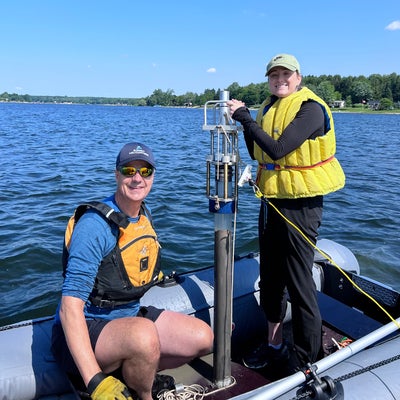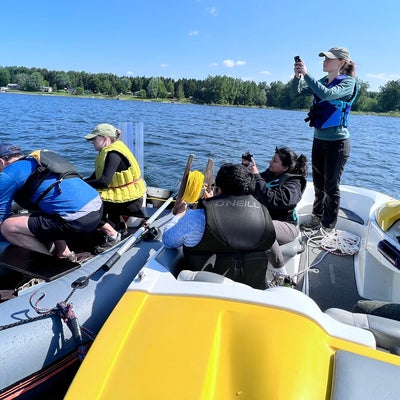A look into the past: Microplastics pollution in the Grand River Watershed

A WaterLeadership Snapshot
WaterLeadership Snapshots feature articles written by graduate students participating in the Water Institute’s WaterLeadership training program, which focuses on skills development in knowledge mobilization, leadership, and research communication. Here, students describe the value of their research and its potential for ‘real world’ impact.
WaterLeadership is open to all University of Waterloo graduate students, particularly those studying water. Learn about how you can participate in future sessions.
By Meredith Watson
While microplastics are considered an ‘emerging contaminant’, they have been found nearly everywhere, even in so-called pristine locations like Antarctica and the human placenta. This ‘emerging contaminant’ status does not mean that plastic is a new problem—Canadian plastic production has increased by 230-fold since the 1950s. The massive increase in plastic production combined with intensive urbanization and population growth in recent decades means there is potential for substantial microplastic accumulation over time in the Grand River watershed, home to the University of Waterloo. Yet, there is no historical record of this.

In response to this lack of long-term data, MSc student, Meredith Watson, is working with the Microplastics Fingerprinting Project and Dr. Roland Hall to develop a long-term record of microplastic accumulation within the Grand River watershed. This is done using paleolimnology, the study of lake sediment cores. The team collected sediment cores from Belwood Lake and Conestogo Lake and extracted microplastics from each 1-cm slice. They then used radiometric dating through the Environment Isotope Lab to establish an age-depth model, meaning that each slice corresponds to a year estimate. This allows for evaluation of microplastic abundance at each year.
Meredith Watson, MSc student
Knowing estimates of the number of microplastics accumulated each year can reveal certain insights, such as which years have more microplastic pollution than others, or what might be driving these trends. They hope to understand more about how these microplastic trends correspond with long term trends in land use, plastic production, or climate.
Contrary to what was expected, current results show no increase through time in the accumulation of microplastics since the 1950s. This suggests that factors other than simply the increase in microplastic production may be driving microplastic deposition in reservoir sediments.
In conducting this research, results will provide an understanding of the factors affecting microplastic movement and deposition within the Grand River watershed. Understanding these pathways can inform decision making to mitigate further microplastic contamination within the Grand River watershed and similar urban and agricultural river networks.
This research is supported by a NSERC Alliance Grant under the Plastics science for a cleaner future program. Meredith's work is contributing to the project, "Microplastics Fingerprinting at the watershed scale: from sources to receivers" led by Principal Investigator Philippe Van Cappellen.
Photo by: Grand River Conservation Authority



